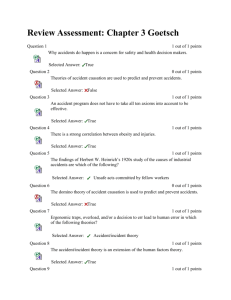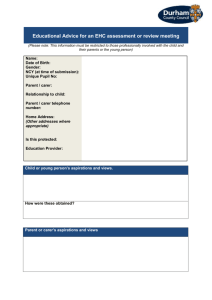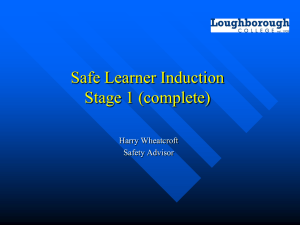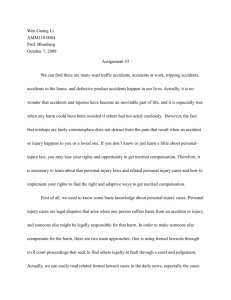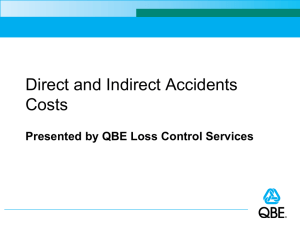Policy for Continuing Professional Development CPD
advertisement
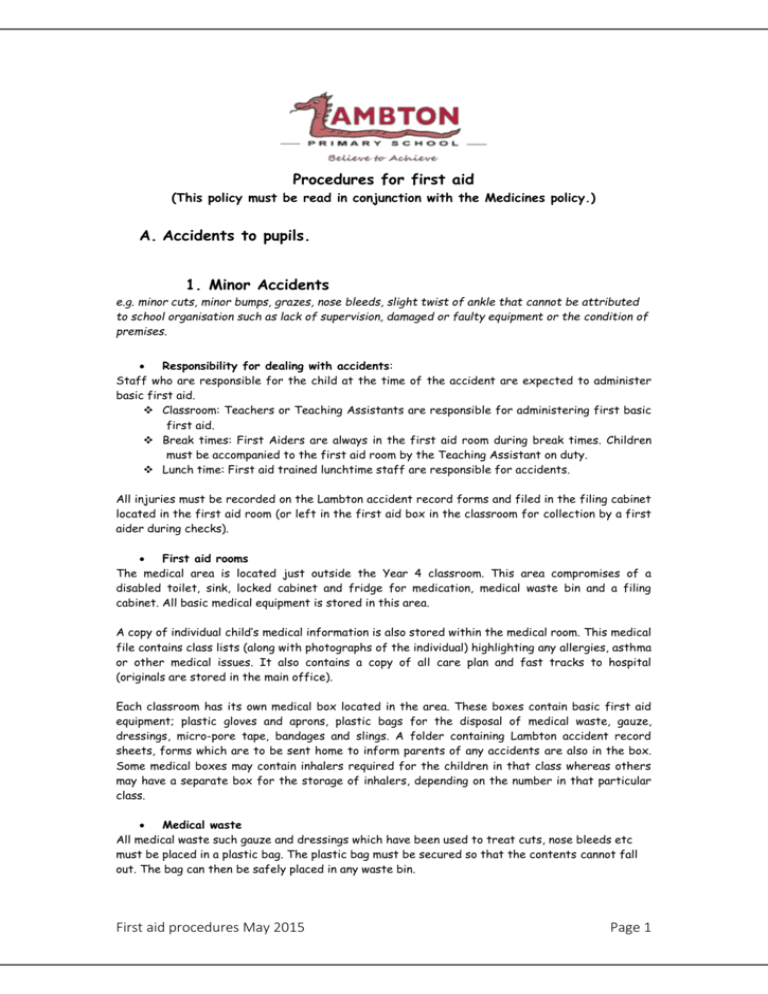
Procedures for first aid (This policy must be read in conjunction with the Medicines policy.) A. Accidents to pupils. 1. Minor Accidents e.g. minor cuts, minor bumps, grazes, nose bleeds, slight twist of ankle that cannot be attributed to school organisation such as lack of supervision, damaged or faulty equipment or the condition of premises. Responsibility for dealing with accidents: Staff who are responsible for the child at the time of the accident are expected to administer basic first aid. Classroom: Teachers or Teaching Assistants are responsible for administering first basic first aid. Break times: First Aiders are always in the first aid room during break times. Children must be accompanied to the first aid room by the Teaching Assistant on duty. Lunch time: First aid trained lunchtime staff are responsible for accidents. All injuries must be recorded on the Lambton accident record forms and filed in the filing cabinet located in the first aid room (or left in the first aid box in the classroom for collection by a first aider during checks). First aid rooms The medical area is located just outside the Year 4 classroom. This area compromises of a disabled toilet, sink, locked cabinet and fridge for medication, medical waste bin and a filing cabinet. All basic medical equipment is stored in this area. A copy of individual child’s medical information is also stored within the medical room. This medical file contains class lists (along with photographs of the individual) highlighting any allergies, asthma or other medical issues. It also contains a copy of all care plan and fast tracks to hospital (originals are stored in the main office). Each classroom has its own medical box located in the area. These boxes contain basic first aid equipment; plastic gloves and aprons, plastic bags for the disposal of medical waste, gauze, dressings, micro-pore tape, bandages and slings. A folder containing Lambton accident record sheets, forms which are to be sent home to inform parents of any accidents are also in the box. Some medical boxes may contain inhalers required for the children in that class whereas others may have a separate box for the storage of inhalers, depending on the number in that particular class. Medical waste All medical waste such gauze and dressings which have been used to treat cuts, nose bleeds etc must be placed in a plastic bag. The plastic bag must be secured so that the contents cannot fall out. The bag can then be safely placed in any waste bin. First aid procedures May 2015 Page 1 Spillage boxes are located in the KS1 corridor, outside the ICT suite in KS2 and in the Nursery Building. 2. More serious accidents. E.g. bumped heads, bad fall, serious cut or bruising, suspected broken limbs, difficulty breathing, unconsciousness. If in doubt, do not move the child. The teacher, Teaching Assistant or Lunch-time Assistant should send another child/adult to look for a first aider. The head teacher should be informed. If it is a possible life threatening injury, telephone for an ambulance immediately and then inform the child’s parents/carer as quickly as possible. Bumped heads All children with bumped heads must be accompanied by an adult to be seen by a first aider. The Head Teacher or Deputy and the child’s parents should be informed. The parent/carer should be asked to come into school to check their child and decide whether or not to take the child home. If they choose to leave the child at school then the child should be given a bumped head sticker or bracelet to wear to inform other members of staff of their injury so they can be monitored. If the child is sent home they must have a ‘bumped head letter’ which contains useful phone numbers and things to look out for with a head injury. In some cases, the head teacher can request that the child be taken home to recover. Anaphylactic attacks: Several children have severe allergies to foods such as nuts or eggs. These children may have prescribed antihistamine or/and an Epipen. All staff throughout the school will be made aware of these children and what they are allergic to. All staff have also been trained in how and when to administer an Epipen. Everyone in school, including the children, knows where this medicine is stored. Epipens are stored in a box clearly labelled emergency box and with the child’s name. This box is kept in the child’s classroom. Children who are prone to anaphylactic shock will have a fast track to hospital care plan. There is a laminated copy of this care plan on the wall next to their medication. If an Epipen is required, an ambulance must be called immediately and they should be informed that the child is having an anaphylactic attack and adrenaline has been administered. The parents should then be informed. The used Epipen should be sent to the hospital with the child. Reportable accidents: All accidents which result in the need for medical attention, whether hospital doctor or clinic, require the completion of an accident report form (IR1) and a Lambton Accident Report form within 24hours of the accident. The IR1 forms are kept in a locked filing cabinet in the school office. The person responsible for the child at the time of the accident completes them (e.g. at break time the teacher on duty). On completion these forms are sent to the Corporate Health & Safety Team and a copy sent to the Local Education Authority. If it becomes necessary for the parent/carer to go directly to the hospital to meet the ambulance a member of staff must accompany the child in the ambulance and remain with the child until the person with parental responsibility arrives. Where a parent arrives and wishes to take the child to hospital by their own transport, the support of a member of staff must be recorded and/ or an offer to call an ambulance. When a child is taken directly to hospital from school the Corporate Health & Safety Team should be notified immediately by telephone (0191 5331755) in order to investigate and if necessary inform the Health & Safety Executive. First aid procedures May 2015 Page 2 3. Accidents to employees All accidents incidents or near misses to employees require the completion of an Accident Report Form (IR1) and a record made in the accident book (Employees) within 24hrs of the accident. The forms and book are kept in a locked cabinet in the school office. On completion these forms are sent to the Corporate Health & Safety Team with a copy to the Local Education Authority. If the injury is serious or likely to result in the employee being absent from work for more than 3 days the then the Corporate Health & Safety Team must be contacted on 0191 5531755 and the IR1 form forwarded as soon as possible to enable the incident to be reported to the Health & safety Executive within 10 days of the incident. Please Note: if an emergency situation arises e.g. difficulty breathing, fainting, possible life threatening injury 999 must be called immediately. Currently the following staff have undertaken First Aid Courses: Joy Falcus Jackie Postill Tracy Tate Karen Kelly Nigel Manser (Paediatric First Aid First Aid at Work) (Paediatric First Aid, First Aid at Work) (First Aid at Work) (Paediatric First Aid) (First Aid at Work) 4. Children who become ill at school. Minor illness/ discomfort: e.g. headache, feeling sick, sore throat, ear/tooth ache. During lesson time, the child remains in class. The teacher should monitor the situation and if the child appears to become worse and does not seem to feel better, then the teacher should ask a first aider to look at the child. If they think the child is so ill they need to go home the office staff should contact the child’s parent/carer. The child remains in class until the parent/carer arrives to take the child home. Children should not be sent to the office if they are feeling unwellas there are times when there is no- one available to watch the child. The child should be signed out by their parent/carer. During the lunch break, a member of the midday staff supervises sick children. The office staff would then contact the parent/carer if the child needs to go home. Emergency contact procedures. Emergency contact numbers for each child are kept in files in the school office and also in the red files within each classroom. These forms are filed in alphabetical order and are renewed and updated annually. The forms also indicate a second contact should be the parent/carer be unavailable. There may be times when it is difficult to decide how ill a child may be. When in doubt contact the parent guardian giving as much information as possible. The parent may wish to come to school to see for him or herself before taking the child home. Ratified May 2015 Next review Summer 2016 First aid procedures May 2015 Page 3

